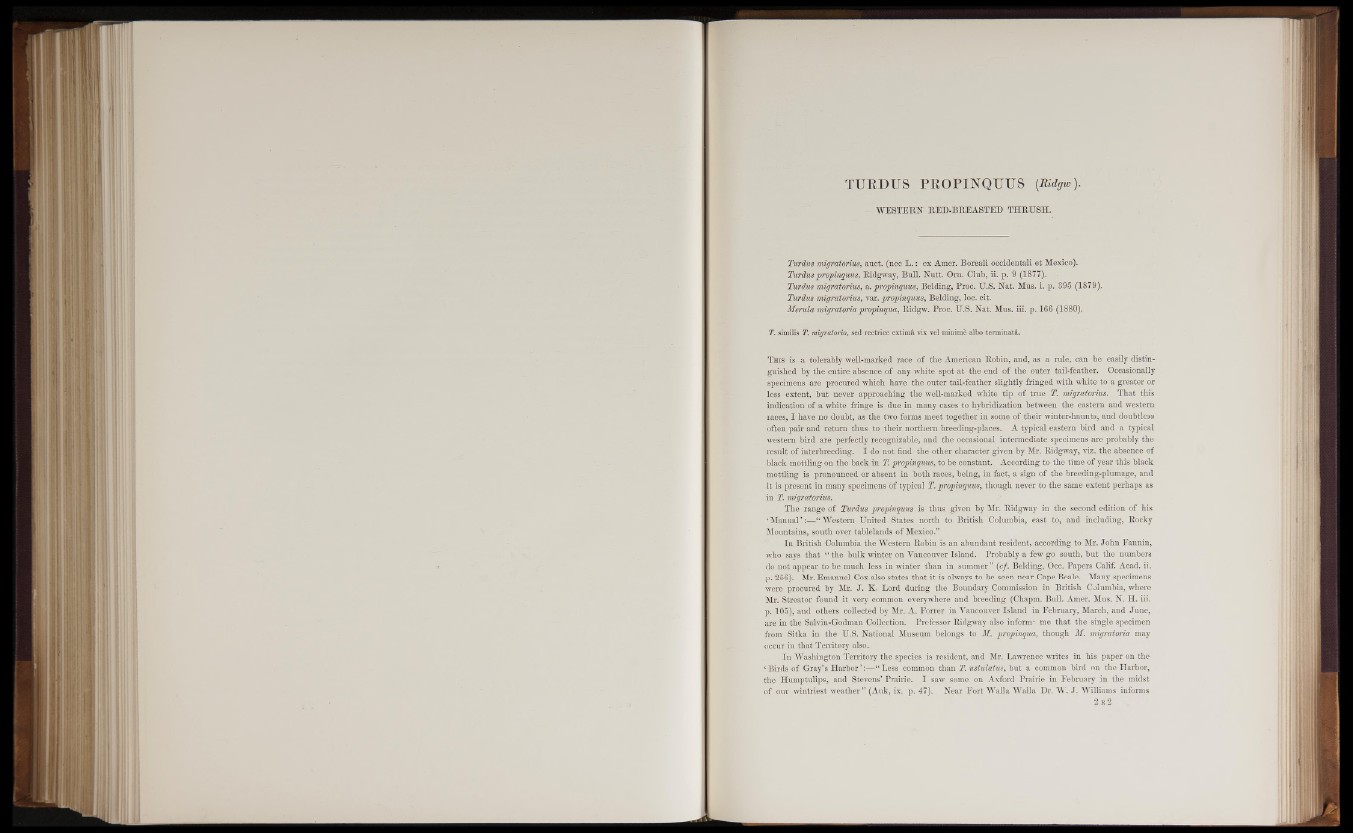
TURDUS PROPINQUUS [Ridgw).
WESTERN RED-BREASTED THRUSH.
Turdus migratorius, auct. (nec L .: ex Amer. Boreali occidentali et Mexico).
Turdus propinquus, Bidgway, Bull. Nutt. Orn. Club, ii. p. 9 (1877).
Turdus migratorius, a. propinquus, Belding, Proc. U.S. Nat. Mus. i. p. 895 (1879).
Turdus migratorius, var. propinquus, Belding, loc. cit.
Merula migratoria propinqua, Bidgw. Proc. U.S. Nat. Mus. iii. p. 166 (1880).
T. similis T. migratorio, sed rectrice extima vix vel minime albo terminate.
T his is a tolerably well-marked race of the American Bobin, and, as a rule, can be easily distinguished
by the entire absence of any white spot at the end of the outer tail-feather. Occasionally
specimens are procured which have the outer tail-feather slightly fringed with white to a greater or
less extent, but never approaching the well-marked white tip of true T. migratorius. That this
indication of a white fringe is due in many cases to hybridization between the eastern and western
races, I have no doubt, as the two forms meet together in some of their winter-haunts, and doubtless
often pair and return thus to their northern breeding-places. A typical eastern bird and a typical
western bird are perfectly recognizable, and the occasional intermediate specimens are probably the
result of interbreeding. I do not find the other character given by Mr. Bidgway, viz. the absence of
black mottling on the back in T. propinquus, to be constant. According to the time of year this black
mottling is pronounced or absent in both races, being, in fact, a sign of the breeding-plumage, and
it is present in many specimens of typical T. propinquus, though never to the same extent perhaps as
in T. migratorius.
The range of Turdus propinquus is thus given by Mr. Bidgway in the second edition of his
‘Manual’ :—“Western United States north to British Columbia, east to, and including, Bocky
Mountains, south over tablelands of Mexico.”
In British Columbia the Western Bobin is an abundant resident, according to Mr. John Fannin,
who says that “ the bulk winter on Vancouver Island. Probably a few go south, but the numbers
do not appear to be much less in winter than in summer” (cf. Belding, Occ. Papers Calif. Acad. ii.
p. 256). Mr. Emanuel Cox also states that it is always to be seen near Cape Beale. Many specimens
were procured by Mr. J. K. Lord during the Boundary Commission in British Columbia, where
Mr. Streator found it very common everywhere and breeding (Chapm. Bull. Amer. Mus. N. H. iii.
p. 105), and others collected by Mr. A. Forrer in Vancouver Island in February, March, and June,
are in the Salvin-Godman Collection. Professor Bidgway also inform1* me that the single specimen
from Sitka in the U.S. National Museum belongs to M. propinqua, though M. migratoria may
occur in that Territory also.
In Washington Territory the species is resident, and Mr. Lawrence writes in his paper on the
| Birds of Gray’s Harbor ’ :—“ Less common than T. ustulatus, but a common bird on the Harbor,
the Humptulips, and Stevens’ Prairie. I saw some on Axford Prairie in February in the midst
of our wintriest weather” (Auk, ix. p. 47). Near Fort Walla Walla Dr. W. J. Williams informs
2 r 2